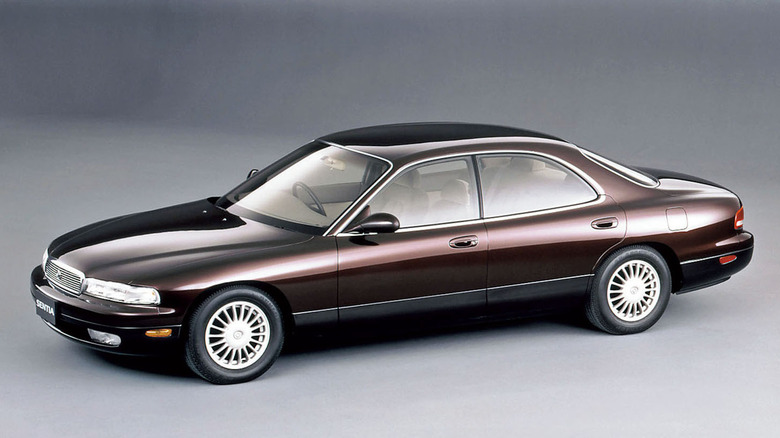What Ever Happened To The Mazda 929?
The car that would become the Mazda 929 was first produced in 1966 and marketed as the Luce in Japan. Over the years that followed, variously labeled generations hit export markets such as Europe and Australia. By the time that the vehicle was on its fifth generation, it was ready for the U.S. — arriving in 1986 and named the Mazda 929.
This first version sold stateside looked like a larger model of the mid-size Mazda 626 sedan, but that would change with the Mazda 929 that arrived in 1992. This second model for the U.S. market was longer, lower, and wider. It was designed as a premium, upscale vehicle in appearance, with rounded contours, a luxurious interior, and a stance inspired by the BMW E34 5 Series. It was equipped with a 3.0 liter V6 with 195 hp and drove the rear wheels through a four-speed automatic transmission.
Known in the Japanese market as the Mazda Sentia, there was also an available upgrade model including Sentia luxury options as standard at the short-lived deluxe brand Anfini — the vehicle named the Anfini MS-9. Mazda cars were made out of the factory in Hiroshima, Japan.
1992 was a difficult time for Japanese automakers
These were the heady days when Japanese manufacturers were achieving great success in the U.S., looking to expand from a solid foothold in the mass market. Brands saw the luxury arena as the next area of opportunity. In 1989, Toyota introduced the Lexus brand and Nissan brought out its Infiniti vehicles. Mazda also decided to create a luxury brand, Amati, in 1991. However, the economic perils that were to hit the company, forced it to cancel plans only the following year.
The 1992 Mazda 929, had a number of expensive features that pushed its price skyward. These included solar cells built into the sunroof panel to power interior cooling fans for the car when parked, a two-tone color scheme with contrasting upper dash and door panels, and plushly upholstered leather seats which took four years to develop.
In Japan, a stock market bubble burst causing prices to drop by around 60 percent by 1992. Land prices sank, and companies that had borrowed heavily to finance expansion now had excessive debt and faced a slowing economy. For Japanese automakers, it was a very bad time and luxury market car sales tanked. Furthermore, falling foul of Japanese tax regulations the locally sold Mazda 929 models were taxed as luxury cars, based on vehicle and engine size, making them more expensive to own. A version of the vehicle sold in South Korea as the Kia Enterprise (see image above).
[Featured Image by Chu via Wikimedia Commons | Cropped and scaled | CC-BY-SA 3.0]
It was an early look at Mazda's aspirations
The Mazda 929 did not sell well, but it represents the aspirations of Japanese auto manufacturers to compete upmarket with the newly-established premium brands from its own country. As mentioned, Mazda was forced to cancel its plans for the Amati franchise — luxury buyers who might be attracted to Lexus, Infiniti, or Honda's Acura brand, did not seek out a Mazda dealer when car shopping. Eventually, Mazda's 929 sales dropped to the point where the car would no longer be in U.S. showrooms by late 1995.
Although, the economic headwinds of the 1990s did not allow Mazda to establish a luxury franchise, this has not stopped the company from trying to build an image of itself as a step above Toyota, Honda, and Nissan. Mazda officials have described this sweet spot as "Japanese premium."
The current quality of Mazda's styling, beautiful interiors, and dealership upgrades reflect this desire, as do the current prices of its top trim levels. The 3.3 Turbo S Premium Plus version of the Mazda CX-90 SUV flagship is proof of this, with its Nappa leather seats, Japanese maple trim, 340 hp inline-six turbocharged engine, and $61,325 sticker price. What Mazda could not achieve in the 1990s with the 929 may be within its grasp today.
[Featured Image by OSX via Wikimedia Commons | Cropped and scaled | Public domain]


